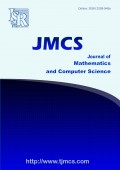Optimal Control of HIV Infection by Using Fuzzy Dynamical Systems
-
3955
Downloads
-
5605
Views
Authors
M. Najariyan
- School of Mathematics, Ferdowsi University of Mashhad, Iran
M. H. Farahi
- School of Mathematics, Ferdowsi University of Mashhad, Iran, and the center of excellence in modelling and computations in linear and nonlinear systems (CRMCS)
M. Alavian
- Islamic Azad University, Mashhad, Iran
Abstract
A dynamical system represent the infection and propagation of HIV is considered. First a mathematical
model for the HIV is simulated. Since age, sex… are important parameters in treatment of HIV disease,
it is natural to consider the variables as fuzzy variables. Thus we need to consider a fuzzy dynamical
system to control the HIV disease. To solve such a fuzzy dynamical system, by using α-cuts, one can
convert this system to a non-fuzzy system of differential equations, then by using numerical methods
one may attempts to solve these differential equations
Share and Cite
ISRP Style
M. Najariyan, M. H. Farahi, M. Alavian, Optimal Control of HIV Infection by Using Fuzzy Dynamical Systems, Journal of Mathematics and Computer Science, 2 (2011), no. 4, 639--649
AMA Style
Najariyan M., Farahi M. H., Alavian M., Optimal Control of HIV Infection by Using Fuzzy Dynamical Systems. J Math Comput SCI-JM. (2011); 2(4):639--649
Chicago/Turabian Style
Najariyan, M., Farahi, M. H., Alavian, M.. "Optimal Control of HIV Infection by Using Fuzzy Dynamical Systems." Journal of Mathematics and Computer Science, 2, no. 4 (2011): 639--649
Keywords
- Fuzzy differential equations
- nonlinear programming
- discretization method
- HIV
MSC
- 93C42
- 93C40
- 93C85
- 34A07
- 46S40
- 34C60
- 49K15
References
-
[1]
M. A. Nowak, R. M. May, Mathematical biology of HIV infections, Antigenic variation and diversity threshold, Mathematical Biosciences, 106 (1991), 1--21
-
[2]
A. N. W .Hone, Painleve tests, singularity structure and integrability, arXiv.org , 2005 (2005), 1--34
-
[3]
M. A. Capistran, F. J. Solis, On the modeling of long-term HIV-1 infection dynamics, Mathematical and computer modeling, 50 (2009), 777--782
-
[4]
M. A. Nowak, R. M. May, Virus dynamics, Oxford University Press, Oxford (2000)
-
[5]
A. S. Perelson, P. W. Nelson, Mathematical analysis of HIV-1 dynamics in vivo, SIAM review, 41 (1999), 3--44
-
[6]
A. S. Perelson, Modeling the interaction of the immune system with HIV, in: Mathematical and statistical approaches to AIDS epidemiology, 350--370 (1989)
-
[7]
A. S. Perelson, D. E. Kirschner, R. De Boer, Dynamics of HIV infection of \(CD4^+\) T cells, Mathematical biosciences, 114 (1993), 81--125
-
[8]
P. K. Srivastava, P. Chandra, Modeling the dynamics of HIV and \(CD4^+\) T cells during primary infection, Nonlinear Analysis: Real World Applications, 11 (2010), 612--618
-
[9]
L. M. Wein, S. A. Zenios, M. A. Nowak, Dynamics multidrug therapies for HIV: A theoretic approach, Journal of Theoretical Biology, 35 (1997), 15--29
-
[10]
D. Kirschner, S. Lenhart, S. Serbin, Optimal control of the chemotherapy of HIV, Journal of Mathematical Biology, 35 (1997), 775--792
-
[11]
M. J. Mhawej, C. H. Moog, F. Biafore, C. Francois, Control of the HIV infection and drug dosage, Biomedical Signal Processing and Control, 5 (2010), 45--52
-
[12]
R. Jafelice, L. C. Barros, R. C. Bassanezi, F. Gomide, Fuzzy rules in asymptomatic HIV virus infected individuals model, Frontiers in Artifical Intelligence and Applications, 85 (2002), 208--215
-
[13]
R. M. Jafelice, L. C. De Barros, R. C. Bassanezi, F. Gomide, Methodology to determine the evolution of asymptomatic HIV population using fuzzy set theory, International Journal of Uncertainty, Fuzziness and Knowledge-Based Systems, Vol. 13, 39--58 (2003)
-
[14]
L. C. Barros, R. C. Bassanezi, M. B. Leite, The epidemiological models SI with fuzzy parameter of transmission, Comput. Math. Appl., 45 (2003), 1619--1628
-
[15]
N. Ortega, L. C. Barros, E. Massad, Fuzzy gradual rules in epidemiology, Kyberentes: Int. J. Syst. Cybernetics, 32 (2003), 460--477
-
[16]
V. Křivan, G. Colombo, A non-stochastic approach for modeling uncertainty in population dynamics, Bull. Math. Biol., Vol. 60, 721--751 (1998)
-
[17]
P. Diamond, P. E. Kloeden, Metric spaces of fuzzy sets: theory and applications, World Scientific, Singapore (1994)
-
[18]
M. L. Puri, D. Ralescu, Differentials of fuzzy functions, J. Math. Anal. Appl., 91 (1983), 552--558
-
[19]
B. Bede, S. G. Gal, Generalizations of the differentiability of fuzzy-number-valued functions with applications to fuzzy differential equations, Fuzzy sets and systems, 151 (2005), 581--599
-
[20]
Y. Chalco-Cano, H. Roman-Flores, One new solution of fuzzy differential equations, Chaos Solitons Fractals, 38 (2008), 112--119
-
[21]
A. Khastan, F. Bahrami, K. Ivaz, New results on multiple solutions for nth-order fuzzy differential equations under generalized differentiability, Boundary value problems, 2009 (2009), 13 pages
-
[22]
Y. Chalco-Cano, H. Roman-Flores, On new solutions of fuzzy differential equations, Chaos Solitons Fractals, 38 (2008), 112--119
-
[23]
J. J. Nieto, A. Khastan, K. Ivaz, Numerical solution of fuzzy differential equations under generalized differentiability, Nonlinear Analysis: Hybrid Systems, 3 (2009), 700--707
-
[24]
K. P. Badakhshan, A. V. Kamyad, A. Azemi, Using AVK method to solve nonlinear problems with uncertain parameters, Applied Mathematics and Computation, 189 (2007), 27--34

